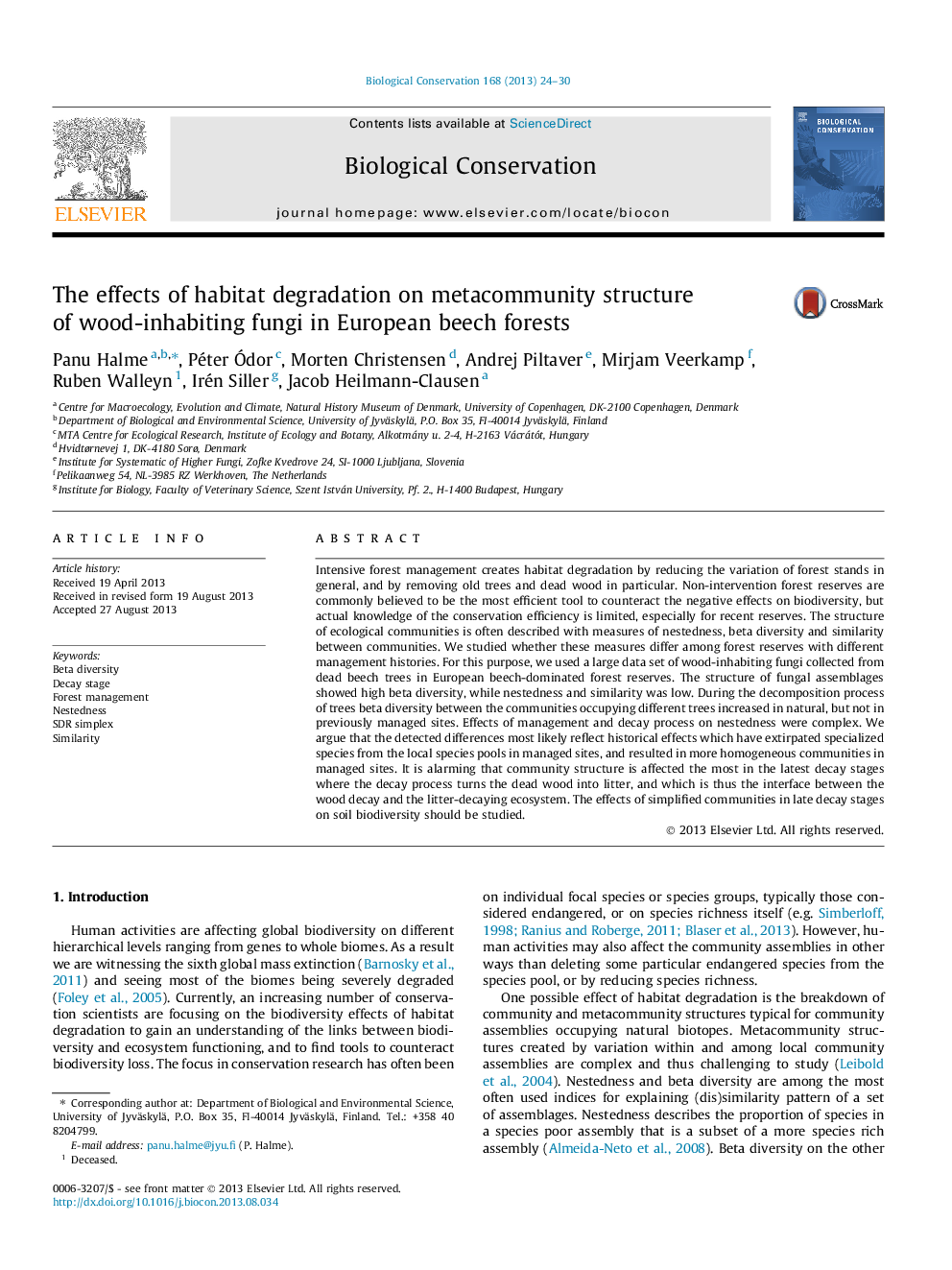| کد مقاله | کد نشریه | سال انتشار | مقاله انگلیسی | نسخه تمام متن |
|---|---|---|---|---|
| 6300335 | 1617933 | 2013 | 7 صفحه PDF | دانلود رایگان |
عنوان انگلیسی مقاله ISI
The effects of habitat degradation on metacommunity structure of wood-inhabiting fungi in European beech forests
ترجمه فارسی عنوان
اثرات تخریب زیستگاه بر ساختار متاکومینیت قارچ های ساحلی در جنگل های رویش اروپا
دانلود مقاله + سفارش ترجمه
دانلود مقاله ISI انگلیسی
رایگان برای ایرانیان
کلمات کلیدی
ترجمه چکیده
مدیریت جنگل های فشرده با کاهش تنوع جنگل ها به طور کلی، و از بین بردن درختان قدیمی و چوب های مرده به طور خاص، باعث تخریب زیستگاه ها می شود. به طور معمول، معتقد است که ذخایر جنگلی غیر مداومی به عنوان موثر ترین ابزار برای مقابله با اثرات منفی بر تنوع زیستی است، اما دانش واقعی در مورد بهره وری حفاظت، به ویژه برای ذخایر اخیر محدود است. ساختار جوامع بوم شناختی اغلب با اندازه گیری تناوب، تنوع بتا و شباهت بین جوامع توصیف می شود. ما بررسی کردیم که آیا این اقدامات در میان ذخایر جنگلی با سابقه مدیریت متفاوت متفاوت است یا خیر. برای این منظور، از مجموعه داده های بزرگی از قارچ های ساکن درختان جمع آوری شده از درختان راش های مرده در ذخایر جنگل تحت پوشش راک اروپایی استفاده شده است. ساختار مجموعه های قارچی نشان دهنده تنوع بتا بالا بود، در حالی که تناوب و تشابه آن کم بود. در طی فرآیند تجزیه درختان بتا تنوع میان جوامع اشغال درختان مختلف در طبقات طبیعی، اما نه در سایت های مدیریت شده قبلی، افزایش یافته است. اثرات مدیریت و فرآیند پوسیدگی بر روی تراکم پیچیده بود. ما استدلال می کنیم که تفاوت های تشخیصی به احتمال زیاد نشان دهنده تأثیرات تاریخی است که گونه های تخصصی را از گونه های محلی محلی در سایت های مدیریت شده حذف کرده و جوامع همگن بیشتری را در مکان های مدیریت شده به وجود آورده است. نگران کننده است که ساختار جامعه بیشترین تأثیر را در آخرین مراحل فروپاشی دارد که در آن فرایند فروپاشی چوب مرده را به بستر تبدیل می کند و در نتیجه رابط بین پوسیدگی چوب و اکوسیستم پوسیدگی خاک است. اثرات جوامع ساده شده در مراحل تخریب اواخر تنوع زیستی خاک باید مورد مطالعه قرار گیرد.
موضوعات مرتبط
علوم زیستی و بیوفناوری
علوم کشاورزی و بیولوژیک
بوم شناسی، تکامل، رفتار و سامانه شناسی
چکیده انگلیسی
Intensive forest management creates habitat degradation by reducing the variation of forest stands in general, and by removing old trees and dead wood in particular. Non-intervention forest reserves are commonly believed to be the most efficient tool to counteract the negative effects on biodiversity, but actual knowledge of the conservation efficiency is limited, especially for recent reserves. The structure of ecological communities is often described with measures of nestedness, beta diversity and similarity between communities. We studied whether these measures differ among forest reserves with different management histories. For this purpose, we used a large data set of wood-inhabiting fungi collected from dead beech trees in European beech-dominated forest reserves. The structure of fungal assemblages showed high beta diversity, while nestedness and similarity was low. During the decomposition process of trees beta diversity between the communities occupying different trees increased in natural, but not in previously managed sites. Effects of management and decay process on nestedness were complex. We argue that the detected differences most likely reflect historical effects which have extirpated specialized species from the local species pools in managed sites, and resulted in more homogeneous communities in managed sites. It is alarming that community structure is affected the most in the latest decay stages where the decay process turns the dead wood into litter, and which is thus the interface between the wood decay and the litter-decaying ecosystem. The effects of simplified communities in late decay stages on soil biodiversity should be studied.
ناشر
Database: Elsevier - ScienceDirect (ساینس دایرکت)
Journal: Biological Conservation - Volume 168, December 2013, Pages 24-30
Journal: Biological Conservation - Volume 168, December 2013, Pages 24-30
نویسندگان
Panu Halme, Péter Ãdor, Morten Christensen, Andrej Piltaver, Mirjam Veerkamp, Ruben Walleyn, Irén Siller, Jacob Heilmann-Clausen,
